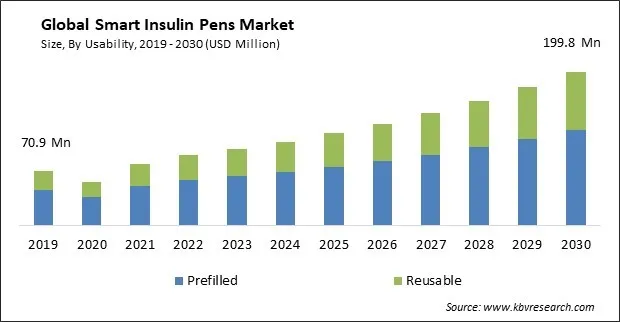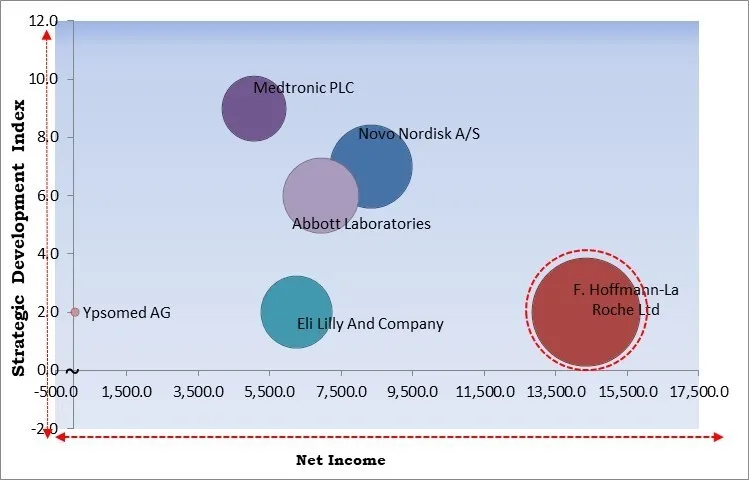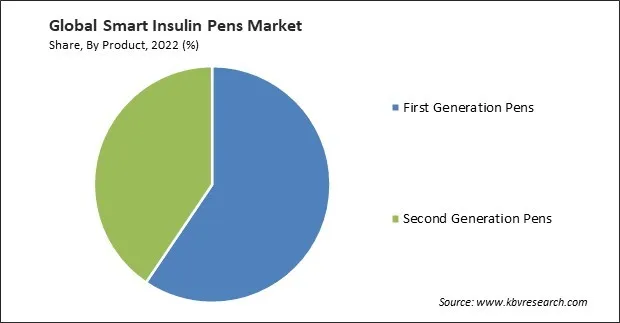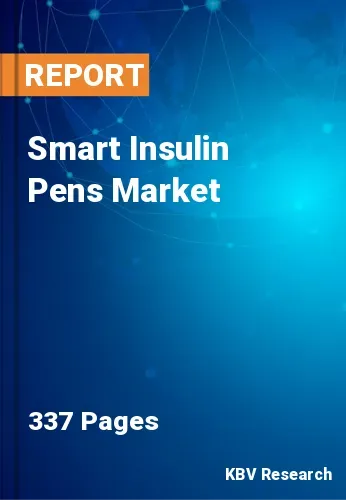The Global Smart Insulin Pens Market size is expected to reach $199.8 million by 2030, rising at a market growth of 10.5% CAGR during the forecast period. In the year 2022, the market attained a volume of 797.8 thousand units experiencing a growth of 9.9% (2019-2022).
Consumers have been inclining towards devices that offer real-time insulin monitoring for better diabetes management. The Second generation smart insulin pens offer more advanced connectivity options, such as seamless integration with mobile apps, cloud storage, and remote monitoring systems which fulfils the need. Consequently, the second generation pens segment would account for nearly 40% of the total market share by 2030. These pens often have more sophisticated data analysis capabilities, allowing users to monitor trends in their insulin usage and glucose levels. The advanced features and user-centric design of second-generation pens foster greater user engagement. These benefits have increased the demand for these products.

The major strategies followed by the market participants are Partnerships as the key developmental strategy to keep pace with the changing demands of end users. For instance, in April, 2022, Ypsomed AG entered a partnership with Abbott, to develop automated insulin delivery solutions. The partnership reinforces the company's commitment to improving diabetes management for patients around the globe. Moreover, in May, 2021, Eli Lilly And Company came into partnership with Roche, to develop diabetes management solutions. Under the partnership, Eli Lilly And Company would combine its Tempo Pen and Tempo Smart Button with a compatible diabetes management platform offered by Roche to develop a comprehensive diabetes management solution for patients around the globe.
Based on the Analysis presented in the KBV Cardinal matrix; F. Hoffmann-La Roche Ltd is the forerunner in the Market. In April, 2021, F. Hoffmann-La Roche Ltd signed a partnership with Novo Nordisk, to develop solutions for data collection of diabetes patients. Under the partnership, Roche would integrate its mySugr's Logbook with Novo Nordisk's connected insulin pens to deliver an enhanced data set along with improved insights. Companies such as Novo Nordisk A/S, Abbott Laboratories and Medtronic PLC are some of the key innovators in Market.

Smart insulin pens and other medical device production and distribution were impacted by the pandemic's disruption of global supply chains. Production costs went up, and there were shortages and delays. Financial hardships for both individuals and healthcare systems resulted from the pandemic's economic uncertainty. However, the need to minimize in-person interactions during the pandemic accelerated the adoption of remote monitoring and telehealth solutions. These pens, equipped with connectivity features, played a role in facilitating remote diabetes management and consultations. Therefore, the pandemic had a moderate effect on the market.
The pens have become more interconnected, allowing users to sync their devices with smartphones and other mobile applications. This connectivity enables real-time data transfer, making it easier for patients to keep track of their insulin administration and share relevant information with their healthcare providers. Additionally, in an effort to address the challenge of insulin depletion, some smart pens incorporate sensors that monitor the amount of insulin remaining in the cartridge. This feature enables users to plan for timely refills, minimizing the risk of running out of insulin unexpectedly. Therefore, the rising demand for connectivity and real-time monitoring in healthcare devices is accelerating the demand for these pens as well.
Regulatory approvals and adherence to standards build consumer trust. Adhering to industry standards and meeting regulatory requirements, these pens are more likely to be adopted by patients and healthcare providers. Moreover, healthcare providers, insurers, and other stakeholders are more inclined to recommend and support these pens that have obtained regulatory clearance. Regulatory agencies establish standards encompassing device design, performance, and manufacturing processes. These standards ensure the consistent quality and reliability of the pens. Thus, regulatory approvals and standards are critical drivers of growth in the market.
The upfront expense of acquiring these devices may deter individuals with diabetes who are price-sensitive or have limited financial resources. The cost of purchasing a smart insulin pen, particularly advanced second-generation devices with cutting-edge features, can be a barrier to access for many potential users. Moreover, not every insurance company reimburses for technologically advanced products as these are comparatively more expensive. In some regions, insurance providers may offer only partial or no coverage for these pens. Consequently, the limited insurance coverage and high initial cost are barriers to the widespread adoption of these pens and can hinder their market growth.
By usability, the market is divided into prefilled and reusable. The reusable segment garnered a remarkable growth rate in the market in 2022. Reusable pens generate less plastic waste than prefilled pens, which require the disposal of the entire device with each cartridge. For people who care about the environment, this may be a crucial factor. Reusable pens offer greater flexibility in dosage adjustment, allowing users to customize their insulin doses as needed, which may be particularly valuable for individuals with variable insulin requirements. Users of reusable pens can select from a broader range of insulin types and brands, giving them more options to tailor their treatment to their needs.
Based on product, the market is characterized into second generation pens and first generation pens. The second generation pens segment procured a considerable growth rate in the market in 2022. Second-generation pens offer more advanced connectivity options, such as seamless integration with mobile apps, cloud storage, and remote monitoring systems. This enables real-time data sharing with healthcare providers, caregivers, and family members. The advanced features and user-centric design of second-generation pens foster greater user engagement. These benefits have increased the demand for these products.

Based on end-user, the market is segmented into hospitals & clinics, ambulatory surgical centers, and home care settings. The home care settings segment acquired a substantial revenue share in the market in 2022. These pens for insulin delivery in homecare settings are expected to gain enormous traction in the upcoming years, as most of the world's diabetes cases are concentrated among the elderly population. Insulin pens used at home can help lower the number of hospital visits, saving patients a great deal of money and time. These pens are the best option for administering insulin at home because of their high level of portability.
| Report Attribute | Details |
|---|---|
| Market size value in 2022 | USD 90.7 Million |
| Market size forecast in 2030 | USD 199.8 Million |
| Base Year | 2022 |
| Historical Period | 2019 to 2021 |
| Forecast Period | 2023 to 2030 |
| Revenue Growth Rate | CAGR of 10.5% from 2023 to 2030 |
| Number of Pages | 337 |
| Number of Table | 651 |
| Quantitative Data | Volume in Thousand Units, Revenue in USD Million, and CAGR from 2019 to 2030 |
| Report coverage | Market Trends, Revenue Estimation and Forecast, Segmentation Analysis, Regional and Country Breakdown, Competitive Landscape, Porter’s 5 Forces Analysis, Company Profiling, Companies Strategic Developments, SWOT Analysis, Winning Imperatives |
| Segments covered | Usability, Product, End User, Region |
| Country scope |
|
| Companies Included | Medtronic PLC, Eli Lilly And Company, Novo Nordisk A/S, F. Hoffmann-La Roche Ltd, Emperra GmbH, Jiangsu Delfu Medical Device Co.,Ltd, Abbott Laboratories and Ypsomed AG |
| Growth Drivers |
|
| Restraints |
|
Region-wise, the market is analyzed across North America, Europe, Asia Pacific, and LAMEA. The North America segment recorded the largest revenue share in the market in 2022. The increasing demand for smart insulin pens in North America can be attributed to the growing prevalence of diabetes, the region's affinity for digital health solutions, insurance coverage, and the endorsement of these devices by healthcare professionals. Moreover, the North America market is a hub for innovation and competition in the healthcare technology sector. This environment has led to the development of more advanced and user-friendly pens, further stimulating demand.
Free Valuable Insights: Global Smart Insulin Pens Market size to reach USD 199.8 Million by 2030
The market research report covers the analysis of key stake holders of the market. Key companies profiled in the report include Medtronic PLC, Eli Lilly And Company, Novo Nordisk A/S, F. Hoffmann-La Roche Ltd, Emperra GmbH, Jiangsu Delfu Medical Device Co.,Ltd, Abbott Laboratories and Ypsomed AG.
By Usability (Volume, Thousand Units, Revenue, USD Million, 2019-30)
By Product
By End User (Volume, Thousand Units, Revenue, USD Million, 2019-30)
By Geography (Volume, Thousand Units, Revenue, USD Million, 2019-30)


This Market size is expected to reach $199.8 million by 2030.
Growing demand for connectivity and real-time monitoring devices are driving the Market in coming years, however, High initial costs and limited insurance coverage restraints the growth of the Market.
Medtronic PLC, Eli Lilly And Company, Novo Nordisk A/S, F. Hoffmann-La Roche Ltd, Emperra GmbH, Jiangsu Delfu Medical Device Co.,Ltd, Abbott Laboratories and Ypsomed AG.
In the year 2022, the market attained a volume of 797.8 thousand units experiencing a growth of 9.9% (2019-2022).
The First Generation Pens segment led the Market, By Product in 2022;there by, achieving a market value of $112 million by 2030.
The North America region dominated the Market, By Region in 2022, and would continue to be a dominant market till 2030;there by, achieving a market value of $73.4 Million by 2030.
Our team of dedicated experts can provide you with attractive expansion opportunities for your business.

